Last-Minute NYC Holiday Gift Guide 🎁
We’ve created a holiday gift guide with presents for the intrepid New Yorker that should arrive just in time—

Find out everything you ever wanted to know about scaffolding and sidewalk sheds! Why are they green? Why are they up so long? How can we get them down!?

In the latest Untapped New York Podcast episode, our founder Michelle Young, who also has a master’s degree in Urban Planning from Columbia University Graduate School of Architecture, Planning and Preservation (GSAPP) does a deep dive into scaffolding, that ubiquitous, necessary, and perpetually present part of New York City’s landscape. To find the answers to all your burning questions about scaffolding, Michelle interviewed three experts: Ken Buettner, President of York Scaffold, based in Long Island City Queens, Manhattan Borough President Mark Levine, and architect Andrés Cortés of Agencie, who designed the Urban Umbrella, the beautiful sidewalk shed you often see in front of upscale businesses, particularly on Fifth Avenue. Listen to the full episode and read on below!
First “untapped” insider tip: All of us, journalists included, have been calling scaffolding by the wrong name. It’s real name? Sidewalk shed.
According to Ken Buettner of York Scaffold, “The Department of Buildings considers a sidewalk shed, a shed, which is a temporary structure that does not have plumbing or electricity, other than for some lighting. It does not have doors and windows. It’s a temporary structure that nobody’s living in. And that is the permit that the Department of Buildings issues for a shed. A scaffold is a totally different structure. If you think about Michelangelo painting the ceiling of the Sistine Chapel, he was supported by a scaffold. The Department of Buildings will issue you a [different] permit for a supported scaffold. The media has a tendency to simplify things because the media thinks that its readers and consumers are stupid! So, therefore, the media has made a new entity that doesn’t exist anywhere, except in its own head, which is a quote, ‘sidewalk scaffold.’ And that is what is really a sidewalk shed.”
According to a statistic from July 2023 released by Mayor Eric Adams and the NYC Department of Buildings, there were nearly 400 miles of sidewalk sheds in the city. That’s almost the distance from Boston, Massachusetts to Baltimore, Maryland. Currently, there are over 8,000 of them up city-wide, according to Manhattan Borough President Mark Levine (as of February 2024 when we interviewed him), and almost 4,000 are in Manhattan alone.
Some interesting statistics were shared in a recent hearing in City Council to re-look at sidewalk shed legislation (more on that to come). Each sidewalk shed stays up for an average of 475 days, which is over a year and a half. They stay up to 23% longer in landmark buildings. But many stay up way, way longer than that.
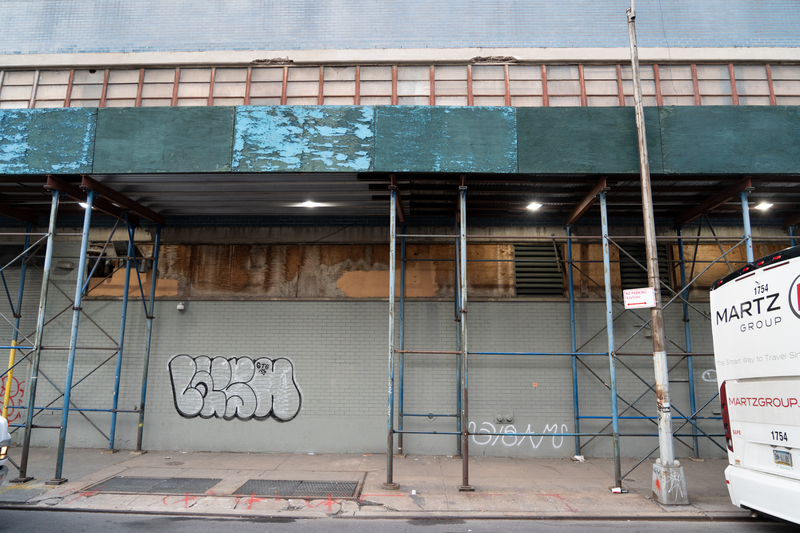
Manhattan Borough President Mark Levine recently released a “Shed the Shed” initiative to address the persistence of sidewalk sheds in New York City and created the hilarious “Sheddies Awards,” which awards the longest-standing sidewalk sheds in the city. The oldest sidewalk shed is currently over 14 years old. In 2023, a sidewalk shed that had been up in Harlem for 21 years was finally taken down.
According to Mark Levine, “The winner, if I can use that term in quotes, is actually a publicly owned building. It’s the building of the city’s Chief Medical Examiner on First Avenue, 520 First Avenue. It’s been up for 14 years. I have tried to untangle what the heck is happening at 520 First Avenue. I think it’s like a jurisdictional fight of some sort. But it’s not a good thing that the city itself is not setting a good example for the public for privately owned buildings. And on average, honestly, I think scaffolding stays up in city buildings even longer than the private buildings, We’ve got to fix that and we have thoughts on what we need to do.” Two landmarked buildings tied for second place at thirteen years. old.
As Ken Buettner explains in the podcast, “A sidewalk shed is really a New York City invention. The building code created sidewalk sheds probably 80 or 90 years ago. And that’s because here in New York, we have greater congestion on our streets and sidewalks than most other major cities. Even 100 years ago, it was like that. So they created the ‘sidewalk shed,’ The sidewalk shed used to be [made of] heavy timbers. People who are old enough or if you have photographs going back, you might see sidewalk sheds being used on demolition sites going back 70, 80 100 years where they were big 12×12 wooden timbers that were vertical, a horizontal structure also using timbers and then the parapet wall around the top of the shed on those ancient sites would often have been the wooden doors that were taken from inside the buildings to be demolished. Nothing was left to waste, and it met the code and it sufficed.” He goes on to explain that over the years, sidewalk shed construction evolved away from timbers to metal the same way 2x4s gave way to metal studs inside buildings. “Many sidewalk sheds still use a wooden decking but you will see many of them have evolved into either cue decking which is a metal deck that is used for a formwork in new construction for concrete. Or you will see sometimes translucent panels on some newer designs.”
As Mark Levine explains, that’s all in the zoning code, which specifies the exact shade of green and the minimum height (eight feet tall). “Another big piece of our policy agenda,” he explains, “is that if you’re gonna put scaffolding, or a sidewalk shed in place, allow it to be less ugly.” Urban Umbrella is one alternative, created during the Bloomberg administration (more on that later as well), but only one company is currently allowed to install it. Levine explains that other cities are doing things like cantilevering scaffolding, using more netting, and allowing for alternative colors or art, “We’re also trying to rethink what these things look like on the street,” he explains.
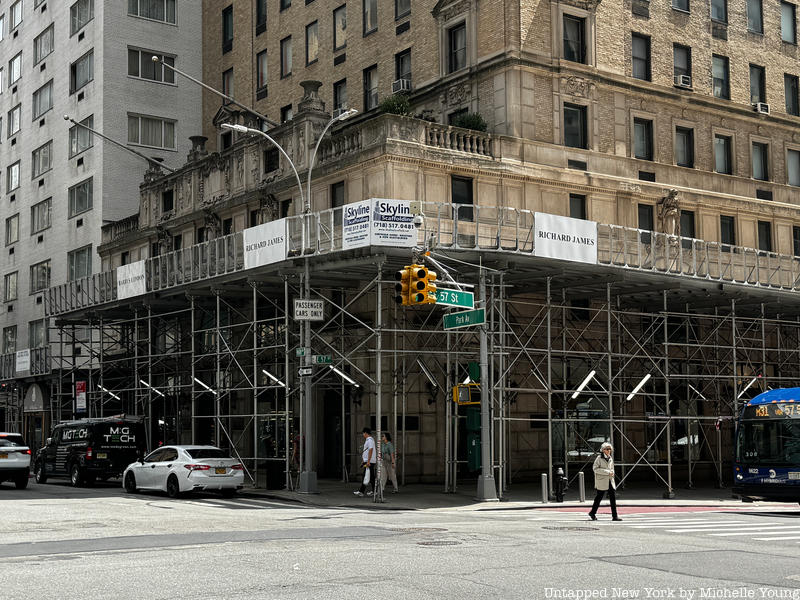
Even if that seems logical—companies would be paid as long as sidewalk sheds stay up—it’s not as simple as that, and for legitimate players in the market, quite the opposite. Ken Buettner explains, “Industry really doesn’t want them to be standing that long. We put up what we know are temporary structures and they’re intended to be up for short periods of time. That may be a couple of months. That may be a year or two. But the sheds are not intended for long-term installation. So we start running into maintenance issues. If a shed is up too long, people point to the industry and say, ‘Oh, you make a load of money because it’s being rented.’ Yes, we do make money being rented if our product is being rented. But we also want to take the sheds down and re-erect parts of them someplace else on a new job. That rental will continue someplace else, so long as the product is still needed.”
That’s a trickier question than you might have been imagining. Mark Levine says sidewalk sheds can cost tens of thousands, perhaps hundreds of thousands depending on the building. Ken explains, “There’s no such thing as just saying it’s so many dollars per square foot to erect the sidewalk shed. That’s kind of like saying, ‘what will it cost me to buy a car?’…When you walk around New York City, all five boroughs, you see sidewalks of varying widths. You have different lengths for the sidewalk shed to be running along the sidewalk depending upon what work is being done. The building code dictates what must be covered. You may wind up having to put up a sidewalk shed that is only the eight-foot minimum height. You may be putting up one that’s 10 feet, 12 feet, 16 feet, 24 feet to cover things below. You have garage spans for driveways coming in and out. You have building entrances that may be multiple doors that require long spans. Sometimes those spans are so long you have to come in with a boom truck to deliver the long-span steel to cover over those entrances. You may have bus shelters, subway entrances, fire plugs, street lamps, newsstands, benches, trees, tree wells, all kinds of things that make sidewalk sheds unique to every location around the city. All of those things have to be taken into consideration before a price can be put together.”
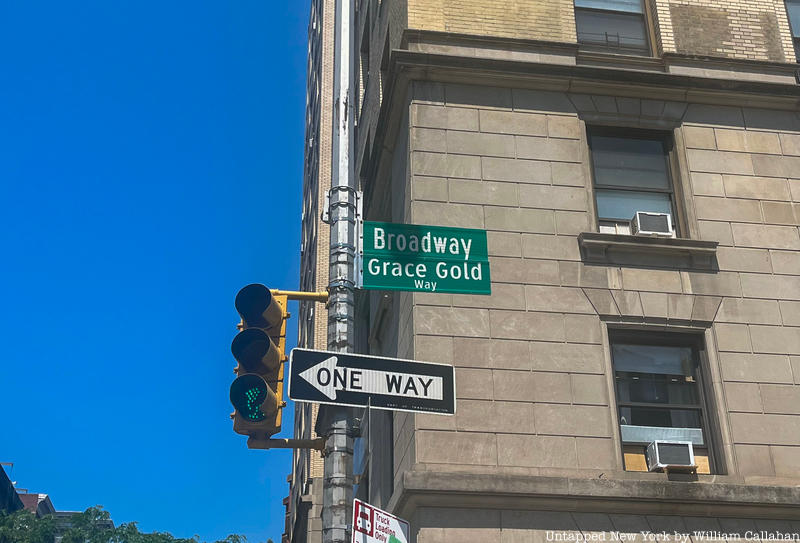
In 1979, a piece of masonry fell off a building on Broadway and 115th Street and killed Grace Gold, a freshman at Barnard who was only 17 years old. Grace grew up in the Brightwater Towers on Coney Island and her sister Lori Gold described her as “a talented writer and singer, she was fluent in Spanish, and she played the guitar. She could have done anything. Instead, she got hit on the head with falling bricks and mortar and her friends watched her die.”
After more accidents and incidents involving falling pieces of facades, Local Law 10 was amended in 1998 and is now called Local Law 11 which requires any façade—not just street-facing ones—that are taller than six stories to be inspected. The amendment also required inspection from a scaffold or other means of support, not just through a visual inspection from the ground.
Ken Buettner explains that as the New York City Building Code accommodated more safety concerns on renovation, restoration, and inspection work, a lot more sidewalk sheds became necessary. As a result, the sidewalk shed and scaffolding industry grew tremendously with a lot more competition and new entrants into the market, including companies that were doing other construction-related activities, such as waterproofing, and moved into the sidewalk shed business and small non-union shops.
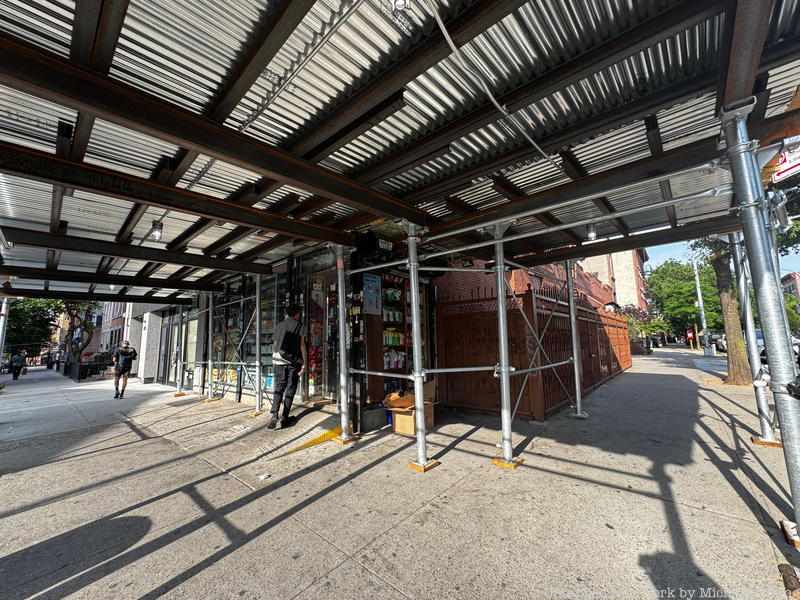
Some steps have already been taken. In July 2023, Mayor Eric Adams announced the “Get Sheds Down” initiative. In less than a year, 4,900 sheds have come down, approximately 55% of all permitted sidewalk sheds. They’ve done it by stepping up criminal court cases against the worst offenders who refuse to make needed building repairs, increasing oversight on expired sidewalk sheds, releasing guidelines using safety netting instead of sheds, and reducing permit lengths, among other initiatives. They’ve also allowed art on sidewalk sheds and retained an outside consulting firm to review what regulatory changes could be made to Local Law 11 that could reduce sidewalk sheds.
Mark Levine explains that some building owners are being deliberately negligent, making the cold calculation that it would be cheaper to rent a sidewalk shed indefinitely than repair a facade, which can get expensive and easily reach into the millions of dollars. “That’s unacceptable and the city needs to intervene in such cases,” he says and explains that the city already has the ability to go in and do urgent repair work and bill the owner, a power that he encourages the city to use. Levine adds, “The city needs to be aggressive about enforcement. And the mayor has ramped up enforcement and is being more aggressive about fines. You actually need a permit even to put a sidewalk shed up, and they are not indefinite. So they’re being a little bit tougher about long-term renewal of the permission to keep the sheds up.” (Mayor Adams and The Department of Buildings have reduced the permit length from twelve months to 90 days).
For owners that want to do the repair work but don’t have the funds, Levine says “for those situations, we need a mix of carrots and sticks. On the carrots front, we have called for the creation of a Zero Interest Loan Fund that the city would make available to building [owners] who want to do the right thing. And they could borrow, zero interest, then they can do the facade work, they could take the sheds down, stop paying a rental fee…It’s a win-win. It’s good for the city, it’s good for pedestrians, it’s good for the co-op.”
Levine says it is also time to modernize Local Law 11, which was the subject of the recent hearing in early July at City Council. A “Get Sheds Down” rally was held on the steps of City Hall in advance of the hearing, with representatives from the city business owners in various New York City business improvement districts present. Department of Buildings Commissioner Jimmy Otto said at the event, “Local Law 11 is Local Law 11 of 1998. Its predecessor was Local Law 10 of 1980. One Mets championship since 1980, zero comprehensive reviews of Local Law 10 and Local Law 11 of our rules governing facades…”
Among the proposals: graduated penalties for longstanding sheds, enforcing building repair deadlines, reducing permit lengths, allowing for the use of drones to inspect buildings taller than six stories, the creation of new sidewalk shed design requirements and alternative protection methods, like using cantilevered platforms, and allowing sheds to be painted to better match their surroundings. City Council should be voting on the bill soon.
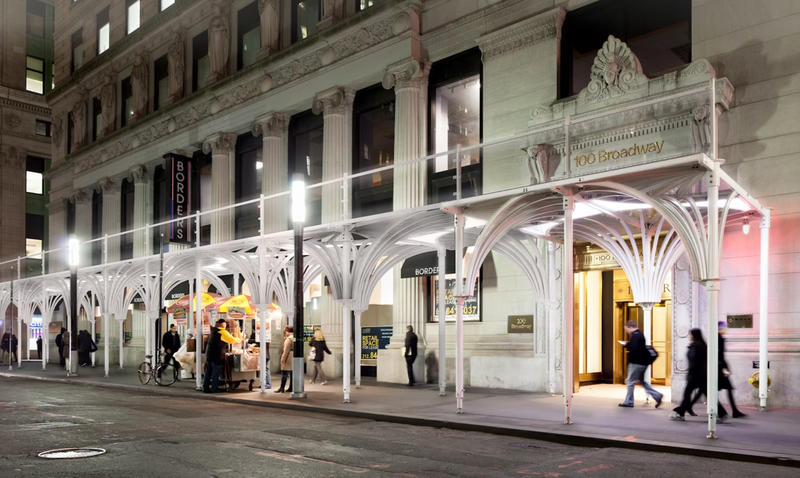
Andrés Cortes, the founder of the firm Agencie, is the architect who designed Urban Umbrella with his wife Sarrah Kahn, an engineer. Andres explained that under Janette Sadik-Kahn, the former commissioner of the NYC Department of Transportation under Mayor Michael Bloomberg, the city hired the firm of Danish architect Jan Gehl to create a series of recommendations on how to improve the public realm in New York City. These suggestions included the creation of bike paths—the still expanding network we know today—pop-up parks, and the need to deal with the sidewalk shed problem. Andrés and Sarrah came up with Urban Umbrella. They’re beautiful, made of white carbon fiber with soaring arches inspired by the shape of shading umbrellas in Medina, Saudi Arabia, and arcades in Italy with natural light flowing in.
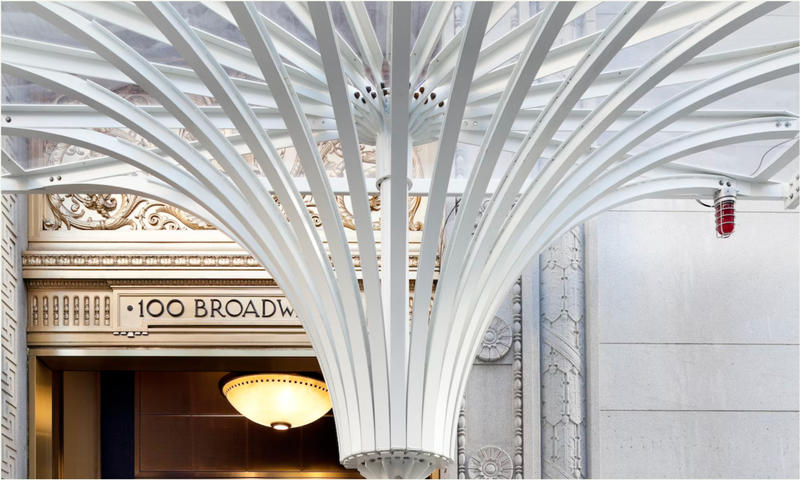
Andrés explains the guiding design motive: “You know, the answer is very easy. The bad thing about sheds is that they clutter the street and they darken the street, right? So really, we just took a position of, well, let’s just do the total opposite. Let’s just declutter the street. And let’s make it visible and transparent, so you can look up and look out and look forward and enjoy the beauty that is New York.” The process of getting something to work took a lot of creativity, ingenuity, and sourcing, especially if they wanted this product to get past the design phase and actually get used. Andrés says it was key to figure out how any system that they designed could be adopted by the industry: “We knew that from a labor force point of view, and from a means and methods point of view, and from a legacy industry perspective, we had to operate within more or less the general languages out there now. There’s vertical posts, there’s horizontal beams, there’s a deck over top, there’s a parapet, the anatomy of a scaffolding system was there.”
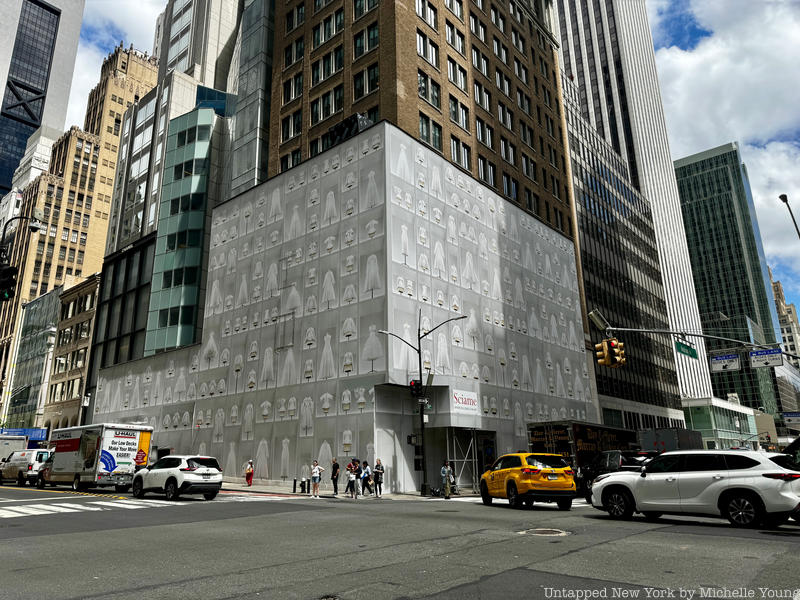
New sidewalk shed designs will be unveiled in 2025, the results of a request for proposals, RFP, from Mayor Eric Adams, the Department of Buildings, and the Mayor’s Office of Contract Services (MOCS), all part of the mayor’s Get Sheds Down initiative.
Two firms, Arup US, an engineering firm, and Practice for Architecture and Urbanism (PAU) were selected through the RFP to help the city create six new aesthetically pleasing, cost-efficient new pedestrian protection designs. These will include both sidewalk-level designs—sidewalk sheds 2.0 let’s say—and non sidewalk-level protection, like netting or fiber mesh systems. All the designs will be open source with any contractor able to use the schematics once they’re approved.
Next, check out our podcast episode on everything you need to know about fire alarm call boxes!
Subscribe to our newsletter